Current as of: May 9, 2025 - 08:00

Iceland Explorer Trip Notes
- Ways to Travel: Guided Group
- Destination: Iceland
- Programmes: Culture
-
Activity Level:
3 out of 7 - Moderate
- 10 Days: Land Only
- Ages: 16+
- Trip Code: AVW
- Carbon Footprint: 11kg CO2e
Trip Overview
Marvel at the star attractions, then discover the secret natural wonders that few know about
Witness the raw beauty of Iceland in full on this immersive adventure, which starts with world-renowned natural wonders, before heading away from the crowds. First up is the understandably popular Golden Circle, before we circumnavigate the island to visit landscapes well away from the typical tourist track. Stark coastlines, immense glaciers and the Eastern Fjords await, as do the dramatic landscapes of the Snæfellsnes Peninsula – a highlight for many, but far too often missed.
Picking your dates: Choose between the frozen landscapes of winter, with the chance to witness the Northern Lights, and the endless days of summer with 24-hour daylight.
At a Glance
- Accommodation: 9 Classic nights (hotels and guesthouses)
- Travel by air-conditioned minibus
- Group normally 5 to 16, plus leader. Minimum age: 16
Highlights
- Experience the immensity of Iceland’s wilderness: fjords, glaciers, volcanos and coasts
- Complete the famed Golden Circle: Gullfoss Waterfall, Geysir and Thingvellir National Park
- Explore the dramatic scenery of the Snæfellsnes Peninsula
- Gaze over Skagafjördur bay from a remote geothermal swimming pool
- Choose between 24-hour sunlight in summer or the possibility of seeing the Northern Lights in winter
Is This Trip for You?
This trip is graded Activity Level 3 (Moderate). For more information on our trip gradings, visit the Activity Level Guidelines page. If you have any queries about the difficulty of the trip, please contact us.
Journeys: Much of this trip is touring by small bus, with plenty of stops. Iceland is bigger than many people expect, so there are some significant distances to travel. Overall, the trip covers around 1,550mi (2,500km) with an average of five hours per day travelling by bus. Days are long and busy with travel or site visits.
Driving times: The transfer times stated in the itinerary, which are based on summer conditions, should be used as a guide only. If road conditions are difficult in winter, the times will be longer. We can reduce the impact of bad road conditions with earlier starts and shorter stops.
Travel: We use a comfortable bus, ruggedly built to Icelandic standards and able to cope with most terrain types. Most roads we travel on this trip are paved, providing a reasonably smooth ride.
Walking: Many site explorations are completed on foot, often on uneven ground. There are sometimes steep and slippery slopes to reach the sites, plus steps and stiles. Some sites have walkways; however, many do not. In winter, ice on the ground can be common; if required, snow grips are provided to fit over regular shoes.
Choosing your dates: Daylight hours vary enormously throughout the year. Here’s what to expect.
- In winter, we depart before sunrise (though this isn’t a particularly early start) to maximise the daylight, meaning we see sunrise every day.
- May, June and the first half of July, we experience 24-hour daylight, before a few hours of darkness around midnight (and the possibility of seeing the Northern Lights) returns.
- From October to April, the roads can be closed with little or no notice due to ice or snow. Even if some roads are open, our tour leader may not deem them safe enough for driving (particularly the road from Egilsstadir to Myvatn via Dettifoss), in which case they take an alternative route. Itinerary alterations due to adverse weather are at the discretion of the tour leader, who always prioritises health and safety over all else.
Group
This is a guided small-group adventure. The group is usually between five and 16 in size, with an average of 12 like-minded people booking individually, in a couple or as friends together.
Adult min age: 16
Min group size: 5
Max group size: 16
Itinerary
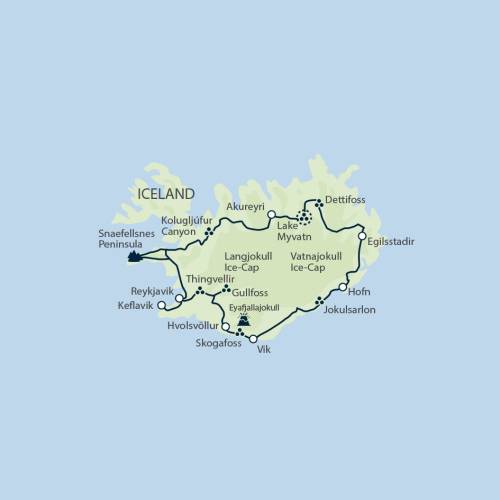
Land Only
- Start City: Reykjavik
- End City: Reykjavik
Land Only Itinerary
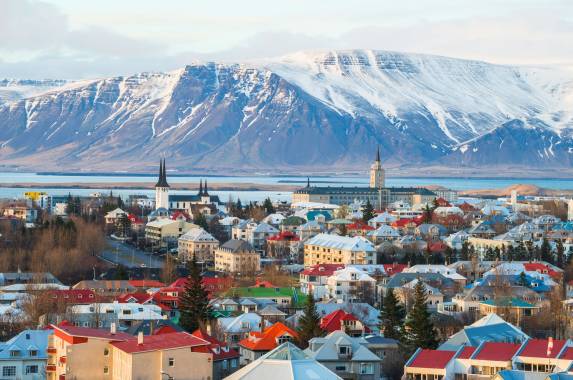
Start in Reykjavik, gateway to the wider wonders of Iceland. Depending on when you land, you may have time to visit the Blue Lagoon. Alternatively, explore the city, including the striking modern architecture of the Harpa concert hall and Hallgrímskirkja church. Our welcome briefing takes place tomorrow morning, when we meet out tour leader for the first time.
Accommodation: Hótel Klettur (or similar)
After a FlyBus transfer from the airport, the trip begins with a briefing at our start hotel in Reykjavik.
Accommodation: Hótel Klettur (or similar)
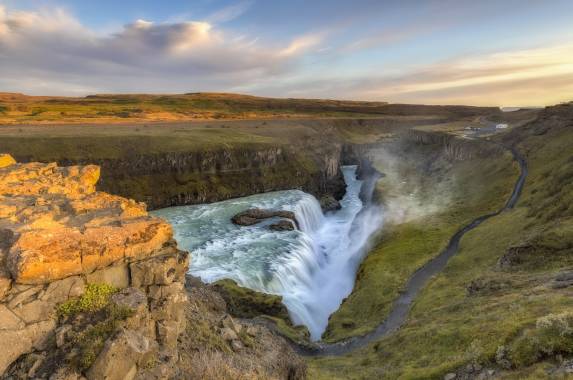
After our welcome briefing at 8.30am, in which we meet the tour leader and discuss the adventures ahead, we drive (45 minutes) inland to Thingvellir, where the world’s first democratic parliament took place.
Sitting on a major fault line, it is the best place in Iceland to see the continental drift – the movement of the Eurasian and North American tectonic plates. Here, they are pulling the earth apart as they inch away from each other, causing the land between to subside.
Unsurprisingly, the area abounds with waterfalls, immense fissures and the largest lake in the country, which we see on our 45-minute exploration.
We then drive (50 minutes) to the world-renowned geysers. Here, we spend 45 minutes (plus an hour for lunch) exploring. The most reliable eruption comes every five to 10 minutes from the 98ft (30m) Strokkur geyser.
We then transfer (15 minutes) to Gullfoss, a huge waterfall in a 230ft (70m) deep canyon forged by the Hvita River (White River). Finally, we drive (1hr 40min) to another beautiful waterfall, Gluggafoss, before finishing the day at our hotel.
Accommodation: Hótel Fljótshlið or Hótel Drangshlíð (or similar)
Drive one hour east to the foot of the infamous Eyjafjallajökull Ice Cap. This area was heavily affected by ashfall during the 2010 eruption and a great deal of ice was melted by the boiling lava. The glacier feeds many beautiful waterfalls, and we visit two of them on a 1hr 30min exploration: Kvernufoss and Skógafoss. Both have rushing water dropping 197ft (60m), and, in the case of Skógafoss, a wall of water rushing down in an 82ft (25m) wide sheet.
Continuing east, we cross the black flood plain of Solheimasandur before reaching the green valley of Myrdalur and continuing to Dyrhólaey – a 30-minute journey overall. This 394ft (120m) high promontory is the southernmost point in Iceland. It is rich in bird life and a nesting site for puffins and Arctic terns in spring. On calm days, we might see whales and seals from the promontory. We continue (25 minutes) further east to Vik, the southernmost town in Iceland and a great place to see the Reynisdrangar sea stacks. If time and conditions allow, we see them at closer proximity from Reynisfjara black beach.
Then travel further across the Mýrdalssandur and Skeiðarársandur flood plains. Both were formed by countless floods created by volcanic eruptions. We head for Vatnajökull National Park, home to the largest ice cap in Europe (also called Vatnajökull), and then to Jökulsárlón glacier lagoon (a three-hour drive from Vik), where thousands of icebergs are separating from the largest glacier in the country and floating in the pale green sea-level lagoon.
Take a one-hour walk beside the waters for excellent views. If conditions allow, head to the black-sand beach where ice chunks are washed onto the shore by the sea, creating wonderful shapes and formations. We then continue (20 minutes) further east, with the steep mountains of Vatnajökull on one side and the exposed south coast on the other, to our accommodation.
Accommodation: Guesthouse Gerði (or similar)
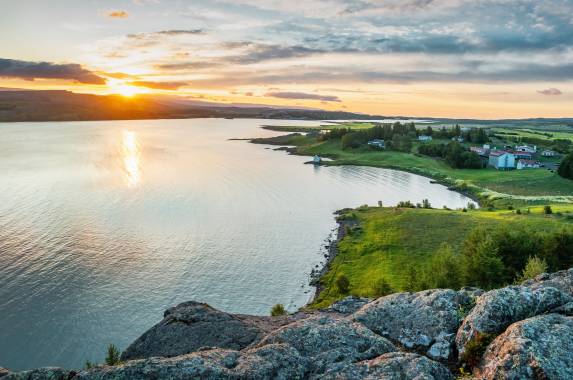
Today is a day of scenic driving (5hr 20min in total) with several stops as we travel through fjord country. This stunning mountain region has been sculpted as much by glaciers as volcanic activity. The road winds from one fjord to another, passing a few farms in each fjord where there is enough flat land for hayfields. The birdlife is rich and, in late summer, thousands of moulting whooper swans feed in the sheltered lagoon of Alftafjordur (Swan Fjord). We continue to the town of Egilsstadir.
Accommodation: Hótel Valaskjálf or Hótel Hallormsstaður (or similar)
Heading inland and west, we drive (1hr 10min) through the starkly contrasting desert scenery of the northeast highlands and follow the track that takes us to Jokuldalur valley and to Studlagil Canyon, one of the most beautiful canyons of columnar basalt in Iceland, which we explore for 45 minutes.
Then, we transfer (1hr 10min) to Möðrudalur farmstead, the highest inhabited farm in Iceland at 469m (1,539ft) above sea level. We have an hour to enjoy the special views from Möðrudalur, which stretch far and wide across the rugged landscape. From Möðrudalur, we drive (1hr 10min) to the enormous Dettifoss waterfall* and walk 0.6mi (1km) to a great vantage point. This is the most powerful waterfall in Europe, bizarrely set in an arid area of sand and rock formations.
After, we drive (45 minutes) to the Námafjall goethermal area before driving 30 minutes to Myvatn and the pseudocraters at Skútustaðir. Finally, we head (30 minutes) to our hotel at Lake Myvatn.
*The road to Detifoss may not be passable on some winter departures. Your tour leader will assess the local conditions and adapt the itinerary if required.
Accommodation: Sel Hótel or Hótel Laxá (or similar)
Spend the morning around Lake Myvatn and enjoy a 45-minute walk in Dimmuborgir, a vast area of lava towers and natural arches. Only a short distance from Dimmuborgir is Mount Hverfjall, a huge circular crater that’s 460ft (140m) deep and 3,280ft (1,000m) wide. It is one of the most beautiful craters in Iceland, one which erupted some 2,500 years ago and covered the Myvatn area in tephra (fragments of volcanic rock). It is also thought to be one of the largest on the planet. A little further north is the hot-spring cave known as Grjótagjá, made famous by Game of Thrones. After Myvatn, we head (50 minutes) to the Godafoss waterfall, before travelling (40 minutes) to Akureyri, where the afternoon is free to spend at leisure.
Akureyri is a town of 17,000 inhabitants and is the biggest town outside the capital. It is the cultural, commercial and educational centre for northern Iceland and 37mi (60km) south of the Arctic Circle. Akureyri is remarkably green and has the northernmost botanical garden in the world. The Lutheran church in Akureyri is an interesting visit, featuring a stained-glass window thought to have come from a church in London, UK.
As with most towns in Iceland there are also thermal baths, enjoyed as much by the locals as by visitors. And if you just fancy a wander, there are plenty of interesting shops, coffee shops and even ice cream parlours. If you would like to book a whale-watching tour for this afternoon (March-October only), please speak to your tour leader at the welcome briefing.
Accommodation: Hótel Norðurland or Hótel KEA Akureyri (or similar)
Leave Akureyri and drive around the Troll Peninsula via traditional fishing villages. After 2hr 10m, we stop at the magnificent outdoor swimming pool in the village of Hofsos, with 1hr 30min for an optional quick dip (not included). This remote geothermal swimming pool has some of the best views over Skagafjördur bay.
After driving (35 minutes) to the town of Sauðárkrókur for lunch, we transfer (1hr 30min) a little further south to
the Víðidalur valley and enjoy a 45-minute stop at beautiful waterfalls in Kolugljúfur canyon, named after a giantess said to have once lived in the area. From Kolugljúfur, we head (25 minutes) to our hotel.
Accommodation: Hótel Laugarbakki (or similar)
Today, we drive west to the Snæfellsnes Peninsula. After 1hr 15min, we visit a reconstructed Viking house once home to Erik the Red and his son Leif Erikson – the two most famous travelling Vikings. The Eiríksstaðir gives an interesting insight into the life of early settlers and an introduction to the historic tradition of the Icelandic Sagas. From Eiríksstaðir, we transfer (20 minutes) to the village of Búðardalur for lunch, before travelling (1hr 30min) to the fishing village of Stykkishólmur, which we can explore for 45 minutes.
We then transfer (40 minutes) to one of the most photographed mountains in Iceland, Kirkjufell, which admire on a 45-minute walk.
Finally, we drive (40 minutes) to the southern side of the peninsula to our accommodation on the beach, which has great views over the stratovolcano Snæfellsjökull. Jules Verne, in his classic Journey to the Centre of the Earth, describes this as the start point for the characters’ descent. New Age followers consider this area to be one of the Earth’s seven major energy centres.
Accommodation: Langaholt Guesthouse or Kast Guesthouse (or similar)
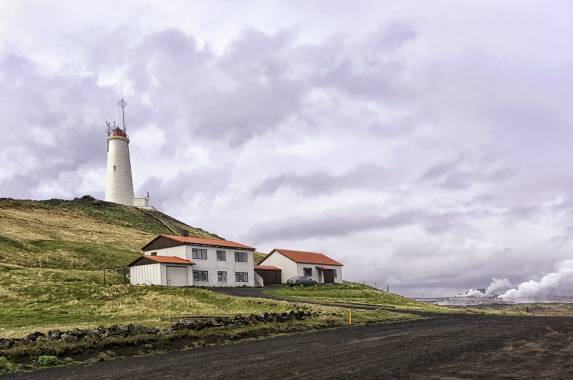
The exposed coast of the Snæfellsnes Peninsula is the goal for today, and this area has recently been designated a national park. We first drive (15 minutes) to the old church at Budir, one of the most picturesque in the country. Then, we transfer (20 minutes) to the sea cliffs at Arnarstapi, which swarms with birds, before heading (20 minutes) to the rocks of Djúpalónssandur and old shipwrecks in black basaltic sand.
Our tour leader will tell us about the old cod-fishing methods, while towering above us is the Snæfellsjökull volcano. Some of the best fisheries are on the peninsula and whales can often be seen from shore on calm days.
After driving (35 minutes) to Ólafsvík for lunch, we transfer (2hr 45min) to our hotel in Reykjavik.
Accommodation: Hótel Klettur (or similar)
Our trip ends in Reykjavik after breakfast. You can catch a Flybus transfer to the airport for your return flight. Alternatively, if you’d like a bit longer to explore this invigorating city, speak to your sales representative about extending your stay.
Please note: It is possible the order of the itinerary listed above will be changed to ensure the best possible conditions for each activity during the trip. All listed activities and services will be included. Your leader will inform you of any changes locally after assessing conditions.
Accommodation
Hotels and guesthouses

This tour stays in a mixture of hotels and guesthouses. Hotels are generally of a three-star standard and selected for their location and good levels of service. Guesthouses are often family-run, offering a warm welcome and traditional Icelandic hospitality.
- Reykjavik: Hótel Klettur
- Hvolsvöllur: Hótel Fljótshlið or Hótel Drangshlíð
- Höfn: Guesthouse Gerði
- Egilsstaðir: Hótel Valaskjálf or Hótel Hallormsstaður
- Myvatn: Sel Hótel or Hótel Laxá
- Akureyri: Hótel Norðurland or Hótel KEA Akureyri
- Laugarbakki: Hótel Laugarbakki
- Snæfellsbær: Langaholt Guesthouse or Kast Guesthouse
The accommodation on this trip consists of twin rooms, although single rooms are also available. While we prebook all accommodation according to the itinerary, as space is limited, we may move to alternative accommodation according to availability. A limited number of single rooms are available, at a supplement on a ‘first come, first served’ basis. Please contact your sales representative for details.
Single supplement from £ 710
Food & Drink
Breakfasts are mainly continental style, lunches are taken in cafes or restaurants, or even service station cafes depending on our location. The main meal of the day is usually local fish or lamb specialities, plus European standards such as pasta and chicken. Vegetarians and those with special dietary requirements can be catered for but may get a less variety in the meals provided. It is still common practice for restaurants receiving big groups to offer a restricted menu. Our tour leader will do their best to ensure as much choice as possible.
Please advise us of any special dietary requirements at the time of booking.
Transport
We use a comfortable van or bus, ruggedly built to Icelandic standards and able to cope with most types of terrain, including fording glacial rivers. Airport transfers are on the Flybus service.
Weather & Seasonality
Summer departures: Iceland is on the northern edge of the temperate zone, meaning it has cool summers. Daytime temperatures in summer can be anything from 10C to 20C (50F to 68F). In mountain areas, be prepared for some days of poor weather with strong winds and rain, but usually the weather is quite pleasant, though cool. There is constant daylight, but not midnight sun, in May, June and July.
Winter departures: On any winter day, you may experience periods of sunshine alternating with short or long showers of snow, sleet or rain. Away from the coast, in most winters, there is good snow cover for much of the season, particularly in the north. Average daytime temperatures in Reykjavik are between 0C and -5C (32F and 23F). In the interior, it can be several degrees colder with significant wind chill. Visibility of the Northern Lights depends on a combination of solar activity and clear skies. The two can combine to produce a visible display any time between late August and April.
Joining Instructions
Key information
Recommended arrival time: You can arrive at any time today. There will be a welcome briefing in the evening, but if you miss it the leader will update you separately
Airport: Keflavik Airport (KEF)
Airport transfers
The start hotel is approximately 45 to 60 minutes’ drive from the airport. Prior to travel, everyone will receive a Flybus voucher, which must be exchanged at the Flybus counter inside the airport or on the first bus for two tickets – one to the hotel and another back to the airport.
The public Flybus system offers bus transfers throughout the day and stops at various city hotels, including our start hotel. You need to carry your own luggage and change bus at the Reykjavik bus terminal to continue your journey to the start hotel. There may be a wait of around 15 minutes between buses. You will receive further details in your Final Joining Instructions.
Why Flybus?
We use Flybus so you have full flexibility to choose the flight times that work best for you. This also means we avoid adding to the road traffic and carbon emissions by having a private bus meet our groups. It is the most cost effective and responsible way to transfer from Keflavik Airport to Reykjavik. If you prefer to be met by a taxi, this can be arranged at an additional cost. Contact your sales representative for more detail
If you would like further information on joining this trip, please speak to your sales representative.
Full joining instructions including local emergency numbers will be sent to you as part of our Final Joining Instructions. If you do not receive these at least a week before departure, or require them earlier please contact our office or your travel agent.
Location start: Reykjavik
Location end: Reykjavik
What To Take
Essential Equipment
Outdoor clothing:
- Good-quality waterproof jacket
- Waterproof trousers (pants)
- Warm fleece
- Thermal underwear, top and bottom, for winter departures
- Balaclava or scarf
- Extra-thick gloves
- Warm hat that covers your ears
- Large water bottle and/or flask
- Trainers/comfortable shoes for the evenings
For thermal pools:
- Towel
- Swimwear
Other:
- Eye mask for 24-hour daylight (summer departures)
- Small backpack for camera, water bottle etc
- Waterproof walking boots (three- or three-to-four-season) with semi-rigid soles and good ankle support are best. Good walking sports shoes may be suitable for summer departures
Optional Equipment
- Mesh head net to protect from midges at Lake Myvatn
- Alcohol is expensive in Iceland, so if you want to enjoy an evening drink, you are advised to buy it in the duty-free shop on arrival in Iceland
Practical Information
Passport
Remember to check the expiration date of your passport if travelling internationally. Many countries require your passport to be valid for at least six months after the date of your scheduled return.
Visa
Iceland
Travellers from the UK, US and EU normally do not need a visa to enter Iceland. Please note, visa requirements often change and it is your responsibility to obtain any required visas for this trip. Therefore, we recommend that you check with the nearest embassy or consulate of your chosen destination(s), including any countries you may be transiting or transferring through.
Some local governments provide guidance on what visas their citizens need. To help, we’ve gathered a selection of useful links below.
• Australia: www.smartraveller.gov.au/destinations/europe/iceland
• Canada: www.travel.gc.ca/destinations/iceland
• United Kingdom: www.gov.uk/foreign-travel-advice/iceland/entry-requirements
• USA: www.travel.state.gov/content/travel/en/international-travel/International-Travel-Country-Information-Pages/Iceland.html
Vaccinations and Health
Iceland
There are no required vaccinations. However, you may want to consider vaccinations for tetanus and rabies. Please confirm with your doctor or travel clinic.
Local Time
Iceland's time zone: Atlantic/Reykjavik (UTC +00:00)
Electricity
Iceland's electricity: Plug types C (two round pins) and F (two round pins) – 230V, 50Hz

Money
Iceland's currency: Icelandic króna (ISK)
ATM Availability
ATMs are available in all main towns and many service stations. Card payments are accepted across Iceland for any amount.
Extra Expenses & Spending Money
Lunch costs around 3,000-4,000 Icelandic króna (approximately US$21-US$28)
Dinner can vary according to the establishment; however, expect to pay 4,000-8,000 króna (approximately US$28-US$55) excluding drinks.
A beer is usually around 900-1,500 króna (approximately US$6-US$10.50), a standard glass of wine is closer to 1,800 króna (approximately US$12.50).
Admission to the swimming pool at Hofsos costs 1,175 króna (approximately US$9).
The Blue Lagoon is a popular destination close to both Reykjavik and Keflavik Airport. Depending on your flight times, you may be able to visit on your arrival or departure day. Destination Blue Lagoon offers packages with transfers between Reykjavik, the Blue Lagoon and Keflavik Airport. Book direct at www.destinationbluelagoon.is or speak to your sales representative for more information.
March-October: During your free day in Akureyri, you may wish to go whale watching. There are tours of different durations (normally two or three hours) and prices start around 12,490 króna (approximately US$87) per person and can go up to 19,990 króna (approximately US$139) per person. Speak to your tour leader at the beginning of the trip to make a reservation.
Tipping
Tipping is not expected in Iceland. Many restaurant or cafe bills will include gratuity.
If you do wish to tip your leader, we recommend around US$25 per person; however, this is entirely at your discretion.
Sustainability and Impact
As a certified B Corp, we’re on a mission to improve our social and environmental impact across all our adventures.
We do this through our innovative Thriving Nature, Thriving People plan.
This ‘nature positive’ approach is designed to help nature and communities thrive in harmony though practical solutions, such as reducing carbon and waste on our trips, supporting conservation projects through the Exodus Adventure Travels Foundation, and rewilding 100 square metres for every Exodus traveller.
Important Information
Water safety
This trip includes time by a lake, river or sea, where there may be opportunities to swim. You should always seek local advice before deciding whether to swim. Open-water or wild swim spots should be treated with extreme caution. Information on how to keep yourself safe while swimming is shown here.
Your safe participation
When booking this trip, you should be confident in your ability to participate in all activities described in these Trip Notes. If you have any doubt about your suitability, please call us and ask to speak to one of the experts on this itinerary.
Although our leaders are well trained to deal with different capabilities, if they have any concerns about someone’s ability to safely take part in an activity, or their impact on other people’s enjoyment, we authorise them to take necessary action which, in some circumstances, may involve asking someone to miss that activity.
By booking this trip you agree to our Booking Conditions which clearly state that our leaders have the authority to do this. In these rare instances we will ensure anyone sitting out is safely provided for and offered alternative options where possible. Refunds will not be provided for activities missed and customers may be liable for additional costs incurred.
Seatbelts
All vehicles used by us should be equipped with working seatbelts, except where approved by us based on the vehicle type or journey. Wherever seatbelts are available, we require our customers to use them for their own safety, even where it may not be a legal requirement.